Publications
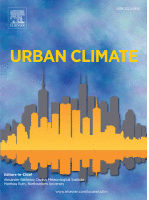
|
V P Lavanyaa Background and baseline levels of PM2.5 and PM10 pollution in major cities of peninsular India https://doi.org/10.1016/j.uclim.2023.101407 Co-authored with Harshitha, K. M., Beig, G., & Srikanth, R. (2023). Background and baseline levels of PM2. 5 and PM10 pollution in major cities of peninsular India. Urban Climate, 48, 101407. |
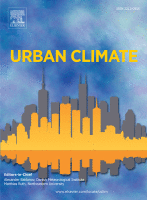
|
Gufran Beig Background and baseline levels of PM2.5 and PM10 pollution in major cities of peninsular India https://doi.org/10.1016/j.uclim.2023.101407 Co-authored with Lavanyaa, V. P., Harshitha, K. M., & Srikanth, R. (2023). Background and baseline levels of PM2. 5 and PM10 pollution in major cities of peninsular India. Urban Climate, 48, 101407. |
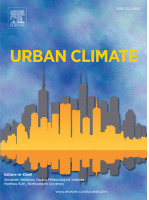
|
R Srikanth Background and baseline levels of PM2.5 and PM10 pollution in major cities of peninsular India https://doi.org/10.1016/j.uclim.2023.101407 Co-authored with Lavanyaa, V. P., Harshitha, K. M., & Beig, G., (2023). Background and baseline levels of PM2. 5 and PM10 pollution in major cities of peninsular India. Urban Climate, 48, 101407. |

|
G Parthasarathy Presence of infratrappean Gondwana sediments below Deccan volcanic covered 1993 Killari earthquake region, Maharashtra (India) and geodynamical instability of the south Indian craton https://onlinelibrary.wiley.com/doi/epdf/10.1002/gj.4716?af=R Geological Journal 58(7): 2473-2489 KLR-1 scientific deep borehole, drilled in the 1993 Killari earthquake region of Maharashtra (India), penetrated 8 m thick infratrappean sediments below a 338 m-thick column of Deccan volcanics that rested over Neoarchean amphibolite to granulite facies mid-crustal basement. Detailed palynological studies revealed the presence of characteristic Gondwana palynomorphs in sedimentary succession that include Plicatipollenites indicus, P. trigonalis, Parasaccites korbaensis, P. diffusus, Microbaculispora indica, Cyclobaculisporites minimus, Cyclogranisporites barakarensis, C. gondwanensis, Jayantisporites pseudozonatus, Leiosphaeridia bokaroensis, Latosporites sp., Verrucosisporites sp., cf. V. ambiplicatus and Striatopodocarpites gondwanensis. Qualitative analyses of palynomorphs would suggest an Asselian age (298–295 Ma) for their formation and burial in dysoxic to anoxic conditions. Recorded palynological assemblages correlate well with continental Lower Gondwana (Early Permian) sediments of India, as well as other Gondwana continents, indicating a larger extent of Gondwana sedimentation than hitherto known today. Petrological studies indicate the presence of two types of carbonate units that overly the crystalline basement. A relatively coarse-grained sparry carbonate rock immediately overlies the basement (Sample KIL-7). The size of the carbonate crystals in the sparite vary from 100 to 500 μm. This unit is overlain by an extremely fine-grained micrite resembling lime mud (Sample KIL-6). Micrite is made of carbonate grains with an average size of 10 μm. X-ray diffraction studies indicate that calcite is the dominant carbonate mineral, while dolomite and quartz occur in minor amounts. Geochemical analyses indicate that in these two samples of carbonate rock that overlie the basement, CaO (33.38 to 38.16 wt %) is higher than MgO (16.0–23.85 wt%). These infratrappeans sediments are also characterized by stable carbon (δ13C) and oxygen (δ18O) isotopic ratios ranging from −1.59 to −8.74‰ and −9.12 to −13.50‰ versus PDB, respectively, thereby conforming to non-marine fresh water deposits. These findings provide first evidences of reactivation and rifting of Dharwar intracratonic regions during earliest Permian Gondwana Period, which led to severe lithospheric mantle destruction, and massive regional uplift and erosion of the granitic-gneissic upper crust. Large scale inland-rifting during the Gondwana sedimentation period was possibly a prelude to India-Antarctic breakup during the early Cretaceous. |
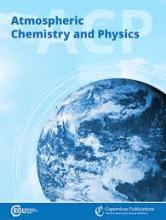
|
Gufran Beig Simulating organic aerosol in Delhi with WRF-Chem using the VBS approach: Exploring model uncertainty with a Gaussian Process emulator https://acp.copernicus.org/preprints/acp-2022-463/ Co-authored with Reyes-Villegas, E., et al. Atmospheric Chemistry and Physics (ACP), Copernicus Publications The nature and origin of organic aerosol in the atmosphere remain unclear. Paper proposes a mechanism and parameterization of them in a high resolution air quality model for India for improved accuracy. |
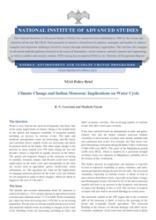
|
BN Goswami, Shailesh Nayak Climate Change and Indian Monsoon: Implications on Water Cycle (NIAS/NSE/EECP/U/PB/04/2023) |
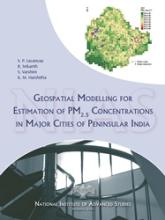
|
V P Lavanyaa, R Srikanth Geospatial modelling for estimation of PM2.5 concentrations in Major cities of Peninsular India https://cms.nias.res.in/sites/default/filesefs/files/about/NIAS_NSE_EECP_U_RR_03_23.pdf Coauthored with S. Varshini and K. M. Harshitha. Research Report No: NIAS/NSE/EECP/U/RR/03/23 Fine particulate matter (PM2.5) pollution is a primary global public health concern. Exposure to PM2.5 pollution beyond the safe limits of exposure is associated inter alia with respiratory and cardio-vascular mortality and morbidity. However, the baseline and background levels of PM2.5 concentration in megacities in India are significantly higher than the WHO Air Quality Guidelines which are based on studies conducted in regions with very low ambient PM concentrations. Human susceptibility to air pollution may vary based on age distribution, nutritional intake, access to health care, meteorological conditions, and any natural immunity. Therefore, it is essential to study the exposure-response function(s) specific to India using the local air pollution exposure studies.
On the other hand, the air quality monitoring stations used to measure ambient PM2.5 concentration are sparse and non-uniformly distributed in urban areas and nearly-absent in rural areas leading to the misclassification of exposure in India.
Therefore, the authors have developed a Linear Mixed Effects model in the present study to estimate PM2.5 levels in four major cities in peninsular India at a spatial resolution of 1 km x 1 km. Bengaluru (801 grids), Hyderabad (873 grids), Madurai (81 grids), and Vijayawada (88 grids) have been selected for this study since they are useful to estimate air pollution exposures for cities with different geographical, climatical, demographic and topographical conditions. |

|
Rudrodip Majumdar Thermochemical Energy Storage Using Radial Flow Annular Reactor for Attaining Lower Pressure Drop https://avestia.com/MHMT2023_Proceedings/files/paper/ENFHT/ENFHT_170.pdf Co-authored with Ankush Shankar Pujari and Sandip Kumar Saha. Proceedings of the 8th World Congress on Momentum, Heat and Mass Transfer (MHMT 2023), March 26 - 28, 2023, Lisbon, Portugal (ISBN: 978-1-990800-17-7) The auxiliary power required in the form of electrical energy for blowing the air through the packed bed reactor is an important consideration since it depends on various design parameters of the system. A radial flow annular reactor configuration is proposed in the present study. It shows a 65%-80% reduction in the flow work requirement. The parameters, such as the flow direction and flow rate, need to be optimized for better performance and to ensure lesser flow work requirements. |
